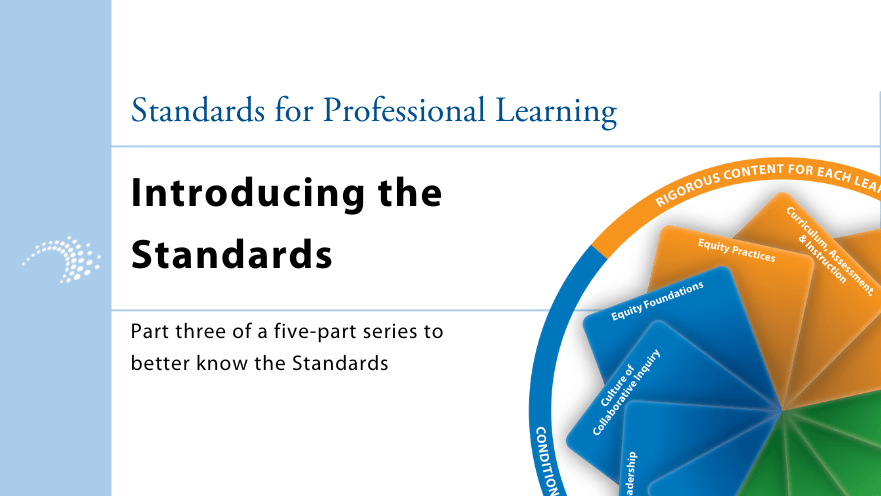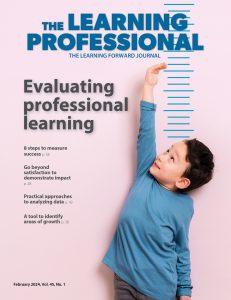Federal, state, and district education leaders increasingly lean on Learning Forward’s Standards for Professional Learning as an essential, evidence-based resource that informs their policy and implementation decisions and helps them evaluate the impact of their investments in high-quality, systemwide professional learning opportunities provided to district teams, teachers, and leaders.
One of standards’ foundations is that policy guides practice. “We know that systems that operate without the cohesive support of innovative policies often stall. That’s why it’s so important that policy and practice work together,” according to Paul Fleming, Learning Forward’s chief learning officer.
“As more lawmakers get to know the power of high-quality professional learning, it is our intent for them to channel that knowledge into shaping good policy and supporting adequate funding through federal sources like Title II or state and district allocations,” said Melinda George, chief policy officer for Learning Forward.
George and Fleming facilitated a webinar exploring how standards and policy combine to move practice, eliciting diverse perspectives from state and district leaders. The webinar was part of a series commemorating the 2022 revision of Standards for Professional Learning.
Missouri
In Missouri, Learning Forward’s standards are embedded in the state’s educator professional learning guidelines, which spell out “what high-quality professional learning looks like,” according to Paul Katnik, assistant commissioner of the Office of Educator Quality at the Missouri Department of Elementary and Secondary Education.
The state uses its Title II set-aside to provide sustained funding for professional learning to support two innovative programs:
- A Title II 3% set-aside for leader professional learning, which funds the Missouri Leadership Development System (MLDS), serving nearly1,000 Missouri principals.
- Title II-A funds that support beginning and mid-career teachers through proprietary professional learning programs like Teacher Academy.
The programs are working. Katnik shared an advocacy data brief that demonstrates that the programs result in increased principal retention and engagement by participating teachers in higher levels of student data, reflective practice, student engagement, and collaborative work in communities of practice.
Missouri tracks MLDS principal participation, which includes more than 1,200 principals. That’s a meaningful number, Katnik said, because “scale matters when you’re trying to create common language around professional learning.”
Missouri’s principal retention rates reflect its commitment to leader professional learning through MLDS. “It’s important for us to know if professional learning contributes to higher rates of retention,” Katnik said. “We’ve seen it in our program year after year – (MLDS principals) outscore the state average by 10 percentage points in terms of retention.”
Expectations for high-quality professional learning throughout Missouri are established through that combination of policy and funding, Katnik said. “We use the standards to create (the state’s) guidelines. We don’t rewrite the standards – we don’t invent them ourselves – we use the good work of Learning Forward.”
“What’s important about putting it in policy is that it’s not a suggestion,” Katnik said. “It’s not invitational. It’s stronger than that. It’s best practice.”
We use the standards to create (state) guidelines. We don't rewrite the standards. We don't invent them ourselves -- we use the good work of Learning Forward. Click To TweetConnecticut
In Connecticut, the state education department adopted Learning Forward’s professional learning standards in 2015 and set up Professional Development and Evaluation Committees to facilitate statewide implementation, according to Jessica Kazigian, senior education specialist with the state and president of Learning Forward Connecticut. Kazigian, who designs professional learning for teachers across Connecticut, said with Learning Forward’s 2022 standards, the state is now “aligning all of our programming moving forward with the new standards.”
A Learning Forward affiliate established in 2020, Learning Forward Connecticut’s membership comprises instructional coaches, teacher leaders, and district leaders. With funding through a Learning Forward Foundation grant program, the organization is developing a strategic plan to position it on “the front edge” of standards-aligned educator professional learning, Kazigian said. “We want to be an advocate to revise the Connecticut learning standards for the next generation of teachers.”
Tennessee
In Tennessee, Fleming said the state embedded Learning Forward’s professional learning standards into its leadership standards as a specific indicator and also into its principal evaluation rubric. Today, Fleming said, “all 1,800 principals have to be aware of and think about deep implementation of the standards through both the state leadership standards and also through practice and evaluation. This is an effective example of how state policy can both guide and inform practice.” Fleming is a former assistant commissioner for Tennessee’s education department. Tennessee’s use of federal Title II funds is detailed in a data summary.
Long Beach Unified School District, California
California’s Quality Professional Learning Standards “align with and echo” much of what has been included in Learning Forward’s 2011 standards iteration, according to Nader Twal, program administrator for Professional Learning and Curriculum Services for Long Beach Unified School District. Statewide standards identify characteristics of professional learning most likely to support educators in building individual and collective capacity to meet professional, school, and student performance expectations. With the standards’ adoption, “the what became very clear,” Twal said. “What was not defined in the legislation is how do we do that? And, how do we know when we are doing it well? There’s a big leap from the what to the how and the how well, and so (Learning Forward’s) standards matter, because they help us to get discrete about the context in which professional development happens in the context that advance adult learning.”
Twal said when assessing the effectiveness of professional learning investments, “What is often measured is participants’ reactions to the training. What we don’t oftentimes have the opportunity to do is to measure the participant learning itself.”
Learning Forward standards Action Guides and Innovation Configuration Maps, Twal said, help education leaders define in role-specific ways “what it looks like when I am actually implementing these things well. The standards offer a clear linchpin between design and implementation, which is the organizational support and learning.”
“The standards help us begin to operationalize aspirations and then begin to show how they’re interrelated so that this work is not event based,” Twal said. “It’s not training based, but it becomes a part of how we do our work daily once the training has happened.”
Policies that support high-quality professional learning
Learning Policy Institute’s “Effective Teacher Professional Development” (2017; Linda Darling-Hammond, Maria E. Hyler, and Madelyn Gardner) studied the positive link between teacher professional learning and student learning outcomes in order to identify and describe common features of effective professional development programs. The bellwether study urged policymakers to incentivize high-quality professional learning by:
- Adopting standards for professional development to guide the design, evaluation, and funding for professional learning provided to educators, such as Learning Forward’s standards.
- Evaluating and redesigning the use of time and school schedules to increase opportunities for professional learning and collaboration, including participation in professional learning communities, peer coaching and observations across classrooms, and collaborative planning.
- Providing flexible funding and continuing education units for learning opportunities that include sustained engagement in collaboration, mentoring, and coaching, as well as institutes, workshops, and seminars.
States and districts should also actively conduct regular needs assessments to identify areas of professional learning most needed and desired by educators; and also provide technology-facilitated opportunities for professional learning and coaching using funding available under Titles II and IV of ESSA to address the needs of rural communities and provide opportunities for intra-district and intra-school collaboration.
“Lawmakers need help understanding the context around the challenges education leaders routinely face,” according to George. “They need to hear from constituents about the power of professional learning and what it can achieve. By aligning their professional learning to the standards, education leaders can ensure that their policies are sound, their investments are meaningful, and most important, that they are improving educator practice that in turn improves student outcomes.”








